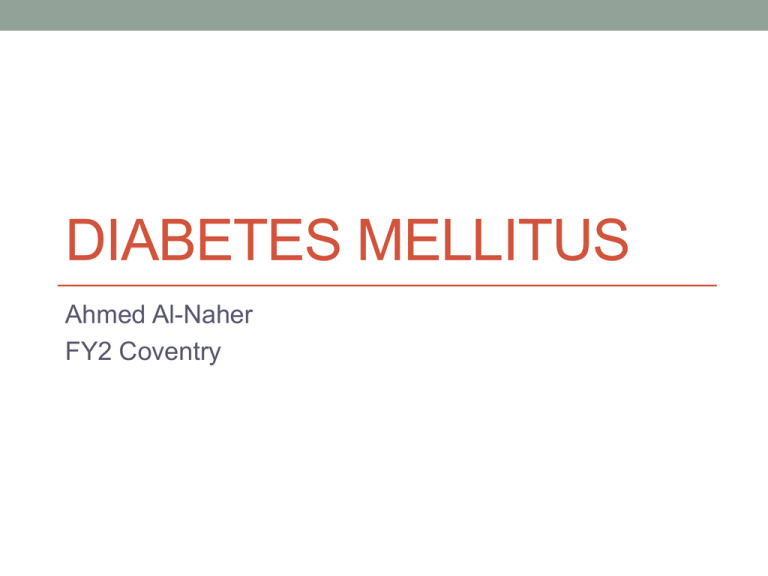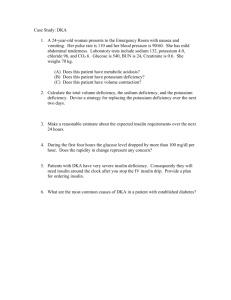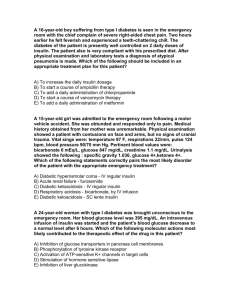Diabetes presentation
advertisement

DIABETES MELLITUS Ahmed Al-Naher FY2 Coventry Case Scenario • 52 male presents to GP with 3/12 lethargy and 2/52 thirsty • • • • • and drinking more than normal. PMH HTN Drinks alcohol socially, non-smoker BMI 32 Urine Dip: glucose +++ Random Blood Sugar = 13 Contents • Diagnosis • Risk Factors • Complications • Investigations • Management • DKA + HONK Type 1 vs Type 2 • Type 1 = Inability to produce insulin (autoimmune process against beta islet pancreas cells) • Type 2 = insensitivity to insulin over time • Gestational Diabetes = decreased insulin sensitivity during pregnancy • Secondary Diabetes: • Pancreatic Disease/CF/Chronic Pancreaitis/Pancreatic Ca • Steroid use/ antipsychotics/ thiazide diuretics Diagnosis • Random Glucose >11.1 mmol/L • Fasting Glucose >7 mmol/L • 2x Fasting glucose samples to confirm • Or presence of symptoms • HbA1c >6.5% (48mmol/L) • OGTT – two hour glucose after 75g glucose • IGT = normal fasting glucose and OGTT between 7-11 • IFG = OGTT <7.8 but fasting glucose 6.1 – 6.9 Risk Factors • T1: Family Hx, Caucasian/Scandinavian, Juvenile onset • T2: • High BMI • Physical inactivity • South Asian/Afro-carribean/middle-eastern • Hx of gestational diabetes, IGT, IFG • Steroid use • PCOS • Family Hx Presentation • Polyuria • Polydipsia • Lethargy • Recurrent infections • Complications • DKA (T1) • HONK (T2) Presentation - case • 67 male admitted feeling generally unwell, SOB, sweating and lethargic over last 2 days. • He is a known Type 2 diabetic on insulin with PVD, peripheral neuropathy and previous CVA. His BM is 5.6. • ECG showed residual ST elevation in anterior leads with Q wave and reciprocal changes. Echo showed new septal hypokinesia • The patient had no history of chest pain Complications • Macrovascular: Stroke, MI, PVD • Retinopathy, Xanthelasma, Cataracts, Opthalmoplegia, maculopathy • Peripheral Neuropathy, Diabetic amyotrophy, neuropathic pain, Autonomic neuropathy • Nephropathy • Recurrent infections: Cellulitis, UTI, Thrush Investigations • Bedside: • Urine Dip: Glucose, ketones, MC+S • BM Stix, Ketone Stix • ECG, BP • Neuro, eye, foot exam • ACR, eGFR, microalbuminuria • Injection sites • Bloods - HbA1c, lactate, pH, U+E, Lipids, LFT, TFT Managing Risk Factors • Lifestyle – Weight loss, Exercise • Education – DESMOND (Diabetes Education and Self • • • • • • • • Management for Ongoing and Newly Diagnosed) Self-Monitoring of BM Dietician, Low sugar diet Smoking cessation Foot Care Eye screening BP Control: ACEi, CCB, Diuretic, K sparing Statins, Fibrates Aspirin Oral Hypoglycaemics • Biguanides – increase insulin sensitivity: Metformin • Sulphonylureas: Gliclazide, Glibenclamide • Meglitinides: Repaglinide, Nateglinide • Thiazolidinediones: Pioglitazone • DDP-4 inhibitors: Sitagliptin, Vildagliptin • GLP-1 Agonists: Exenatide, Liraglutide • Orlistat • Ascarbose Treatment Pathway • 1) Lifestyle Interventions • 2) Metformin • 3) Metformin + sulphonylurea • 4) Metformin + sulphonylurea + Thiazolidinedione or GLP-1 agonist or DDP-4 inhibitor • 4) Metformin + sulphonylurea + insulin • 5) Increase insulin Insulin Types • Rapid-acting: Lispro (Humalog), Aspart (Novorapid) • Short-acting: Soluble Insulin (Actrapid) • Intermediate Acting: NPH (Insulatard) • Long-acting: Glargine (Lantus), Detemir (Levemir) • Ultra long-acting: Degludec • Pre-mixed: Novomix 30, Humalog Mix25, Humumlin M3 • Regimens: • Once Nightly • Twice Daily Biphasic • Basal Bolus • Continuous Pump Prognosis • T1 = increased risk of blindness, ESRF, CVD • Control of BP, Lipids, BM and weight are prognostic • T2 = 75% die of heart disease 15% die of stroke • Every 1% rise in HbA1c level risk of diabetes related death increases by 21% Case Scenario • 58 female T2DM, Portuguese, does not speak English, not complying with medication or dietary advice, admitted with hyperglycaemia and seizures. Continues to have high BMs of >25 on wards and wishes to self-discharge. • She has severe retinopathy blindness and PVD and no carers at home. She is prescribed a pre-mix regimen. • What are the obstacles to safe management of this patient? • What services/ support can be arranged? Medical Emergency: Hypoglycaemia • BM < 3 • Symptoms: low GCS, seizures, clammy, sweaty, tachycardic, behaviour change, slurred speech, shaking • Risk: Strict BM control, Alcohol, malabsorption, Renal failure, medication, lipohypertrophy, hypothyroid • GlucoJuice/Glucotab 10-20g • GlucoGel (Hypostop) • 10% Dexrose IV 150-250ml • Glucagon 1mg IM/SC • Cerebral Oedema: Mannitol, Dexamethasone, 50% Dex Medical Emergency: DKA • Hyperglycaemia, Ketonaemia, Acidosis • Ketones >3mmol/L • BM >11 • pH <7.3, HCO3 <15 • Triggered by stress: Infection, Poor compliance, endocrine crises, CVD, Alcohol, medication DKA signs • Polydipsia, polyuria • Weight loss, lethargy • Vomiting, Abdo pain • SOB (Kussmaul’s respiration) • Low GCS, confusion • Dehydration: dry mucus membranes, reduced skin turgor, sunken eyes, slow cap refill, tachycardia, low BP • Pear Drop Breath • Signs of infection: Fever, crackles, cellulitis • Increased osmolality and anion gap Specific investigations • Serial BMs and Ketones • Serial ABGs or VBGs • Septic Screen: BCM, Urine Dip, CXR • U+E including K • Trop T, CK • ECG • Amylase • CT Head • Monitor BM, Ketones, Acidosis, mental state, fluid status DKA Resuscitation • Correct dehydration: Fast NaCl 0.9% initially • Fixed Rate insulin infusion: 0.1 unit/kg • Reduce BM ~3/hr to avoid cerebral oedema • Continue baseline long acting insulin • Run with NaCl 0.9% + KCl if <5.5 • 10% glucose once BM <14 • Treat underlying cause • Once E+D convert back to normal insulin + DSN r/w • Indications for ITU: haemodynamic instability, cardiogenic shock, respiratory failure, severe acidosis, coma Complications • Cerebral oedema: headache, confusion, urinary • • • • • incontinence, coma – main mortality in children Hypoglycaemia – arrhythmia, coma Hypokalaemia – cardiac arrhythmia VTE Retinopathy ARDS/ Pulmonary oedema • Prognosis worsens with age, low GCS Medical Emergency: HONK • T2DM • Hyperglycaemia, high serum osmolality, no ketosis • Osmotic diuresis -> intracellular dehydration • Triggers: Infection, poor BM control, MI, CVA, endocrine crises, Acute abdo, medication, metformin, alcohol, first presentation • Old age, dementia, steroid use • Severe Dehydration • Low GCS, confusion, seizures • Lethargy, weakness • Abdo Pain, N+V HONK Mx • Ix as for DKA • Initial Fluid resuscitation • Variable Rate Insulin infusion • Run with 8 hourly NaCl + KCl • Treat underlying cause • Review medication • LMWH Final Case • 87 yo male from nursing home with known glioblastoma • • • • multiforme admitted with worsening confusion, reduced mobility and polyuria. CT shows no new haemorrhage, infarct or mass effect DHx frusemide, aspirin and dexamethasone pH 7.2 lactate 2.9 BM 32 Urine: Blood + Leuk + Gluc +++ Nitrites + • Initial management? • Long-term treatment plan? Questions? • http://integrate.ccretherapeutics.org.au/Calculator/UkPds. aspx






